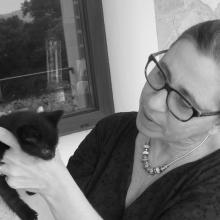Laboratório de Psicolinguística
Research in the Laboratory of Psycholinguistics focuses on language processing at the word and sentence levels.
We employ different experimental techniques (e.g., eyetracking, self-paced reading, lexical priming) to investigate aspects of lexical, morphological, and syntactic processing, in typical and atypical populations (e.g., L1 and L2 speakers, language and reading disorders).
Our research is primarily organized around four main lines:
- L1 and L2 processing, focusing on (a) cross-linguistic differences, particularly on specific properties of European Portuguese and its contrast with other languages and varieties, and (b) the determinants of intra- and inter-individual variability in language processing;
- Language processing from a lifespan perspective, with a focus on the multifaceted outcomes of aging across different linguistic domains and cognitive functions;
- Statistical methods for the language sciences: their development, promotion, and application to questions of psycholinguistic interest;
- Clinical linguistics, including the development of instruments for the assessment and training of linguistic competencies.
Selected publications
- Ciaccio, L., & Veríssimo, J.* (2022). Investigating variability in morphological processing with Bayesian distributional models. Psychonomic Bulletin & Review, 29, 2264–2274. [*equal contribution] https://doi.org/mg7p
- Fernandes, E., Luegi, P., Correa Soares, E., de la Fuente, I., & Hemforth, B. (2018) Adaptation in pronoun resolution: Evidence from Brazilian and European Portuguese. Journal of Experimental Psychology: Learning, Memory, and Cognition, 44, 1986-2008. https://doi.org/gk4ntd
- Freitas, M. J., Lousada, M., & Alves, D. C. (Eds.) (2022). Linguística clínica: Modelos, avaliação e intervenção [Clinical linguistics: Models, assessment, and intervention]. Language Science Press. https://langsci-press.org/catalog/book/358
- Pereira, N., Costa, A., & Guerreiro, M. (2022). Effects of word length and word frequency among dyslexic, ADHD-I and typical readers. Journal of Eye Movement Research, 15. https://doi.org/mx7x
- Veríssimo, J. (2021). Analysis of rating scales: A pervasive problem in bilingualism research and a solution with Bayesian ordinal models. Bilingualism: Language and Cognition, 24, 842–848. https://doi.org/gtgn
- Veríssimo, J., Verhaeghen, P., Goldman, N., Weinstein, M., & Ullman, M. T. (2022). Evidence that ageing yields improvements as well as declines across attention and executive functions. Nature Human Behaviour, 6, 97–110. https://doi.org/gmh3bj
- Villalva, A. (2022). Complex verbs: The interplay of conversion and other word-formation processes. In A. E. Ruz, C. Fernández-Alcaina, & C. Lara-Clares (Eds.), Paradigms in word-formation (249-282). John Benjamins. https://doi.org/mx7w
History
Our research in psycholinguistics began in the early 1980s with the studies of Prof. Isabel Hub Faria on paranoid schizophrenic discourse. A few years later, the ‘Group for the Study of Language and Cognition’ was founded, which brought together researchers in psychology, linguistics, cybernetics, and mathematics. Our first studies on language acquisition took place around this time and contributed to the development of child language corpora.
In the late 1980s, the ‘Laboratory of Psycholinguistics’ was formally recognized as a research group within the Center of Linguistics of the University of Lisbon (CLUL) and we gained access to our first laboratorial facilities. More recently, we have acquired a range of well-equipped facilities for conducting eye-tracking and behavioral tasks, including an experimental booth for data collection and Eyelink eye-trackers (both static and portable).
Throughout its history, the members of the Laboratory of Psycholinguistics have conducted research on aeras such as language processing, reading, speech perception and production, language acquisition and development, second language learning and processing, language disorders, and Portuguese sign language.
Much of this research has involved close collaborations with national and international institutions, including other schools of the University of Lisbon and universities in Brazil (UFP, UFRJ, UFSC), Germany (Goethe Frankfurt, Potsdam) and the USA (Georgetown).
Isabel Hub Faria founded the Laboratory of Psycholinguistics and directed it until 2009. Since then, the research group has been headed by Armanda Costa, Isabel Falé, and currently, by João Veríssimo and Paula Luegi.
Membros
Investigadores integrados com doutoramento
Investigadores integrados sem doutoramento
Colaboradores
Concluídos
| Projeto | Data | Fin. |
|---|---|---|
| Compreensão na Leitura. Processamento de Palavras, Frases e Textos | - | FCT
|
| Recursos | Tipo |
|---|---|
| Economics e-Translations into and from European Languages | Base de dados |
| O guia de pronúncias em português - Port_ProDi | Base de dados |
. (2015). O modelo de descrição no dicionário histórico morfológico: o radical de alto. In (A. M. Ferreira and M. F. Brasete, pp. 523-532). and Aveiro: UA Editora. |
. (1993). Inferno. In Vicente (O. Mateus). Lisboa: . |
. (2023). Bruxas, bruxos e outros tipos destas gentes – histórias de palavras por lexicógrafos do português. In Perspectives de recherche en linguistique et philologie romanes . Bibliothèque de Linguistique Romane. |
. (2023). ANGER IS RED AND FEAR IS WHITE: Universal conceptual metaphors?. In Contextual and Crosslinguistic Facets of Emotion Concepts (pp. 145–159). AVM - Akademische Verlagsgemeinschaft München. |
. (2008). Imperatives in European Portuguese: a perception approach. In ExLing-2008 (pp. 81-84). |
. (2008). Nasometric values for European Portuguese: preliminary results. In ExLing-2008 (pp. 85-88). |
. (2015). Leitura em voz alta, movimentos oculares e prosódia. Integração de informação sintática e discursiva. In Revista da Associação Portuguesa de Linguística (A. Moreno, F. Silva & J. Veloso, pp. 345-395). Porto: APL. http://doi.org/https://doi.org/10.21747/ 2183-9077/rapla16 |
. (2015). Bridging mechanisms of reading, viewing and working memory during attachment resolution of ambiguous relative clauses. In Proceedings of the EuroAsianPacific Joint Conference on Cognitive Science (pp. 264-269). |
. (2015). Parâmetros para análise de narrativas orais em crianças com e sem perturbação da linguagem expressiva. In XXX Encontro Nacional da Associação Portuguesa de Linguística. Textos Selecionados (A. Moreno, F. Silva & J. Veloso, pp. 419-433). Porto: APL. |
. (2015). Priming morfológico nos processos de leitura. In in XXX Encontro da Associação Portuguesa de Linguística. Textos Seleccionados (A. Moreno, F. Silva & J. Veloso, pp. 449-461). Porto: APL. |
. (2015). Mutations lexicales romanes: esquisito, bizarro et comprido. In Comparatio delectat II. Akten der VII. Internationalen Arbeitstagung zum romanisch-deutschen und innerromanischen Sprachvergleich (E. Lavric & W. Pöckl, Wolfgang, Vol. 1, pp. 149-65). Frankfurt am Main: Peter Lang. |
. (2016). Displaying language diversity on the European Dictionary Portal – COST-Enel-case study on colours and emotions and their cultural references. In Proceedings of the XVII EURALEX international congress - Lexicography and Linguistic Diversity. (Margalitadze, T. & Meladze, G., pp. 237-243). Ivane Javakhishvili Tbilisi State University. |
. (2016). Reading aloud: eye movements and prosody. In Speech Prosody 2016 (Vol. 10., pp. 826-830). http://doi.org/http://doi.org/10.21437/SpeechProsody.2016-169 |
. (2017). A inter(in) compreensão de palavras diferentes e de palavras iguais nas variedades do Português de Portugal e do Brasil. In Pelos Mares da Língua Portuguesa 3. Aveiro: UA Editora. |
. (2008). Efeitos de modelização no input: o caso da aquisição de conectores. In Textos Seleccionados do XXIII ENAPL 2007 (S. Frota & A. L. Santos, pp. 131-142). Lisboa: Colibri. |
. (1999). Competitive information sources in referential ambiguity resolution. In Psycholinguistics on the Threshold of the Year 2000 — Proceedings of 5th International Congress of the International Society of Applied Pshycholinguistics (ISAPL 97) (Pinto, M. G.; Veloso, J.; Maia, B., pp. 133-138). Porto: Faculdade de Letras da Universidade do Porto. Retrieved from https://apl.pt/wp-content/uploads/2017/12/1997-16.pdf |
. (1998). Ambiguidade referencial na identificação do sujeito em estruturas coordenadas. In Actas do XIII Encontro Nacional da Associação Portuguesa de Linguística, 1997 (Mota, M.A,; Marquilhas, R. , pp. 173-188). Lisboa: Edições Colibri / APL . Retrieved from https://apl.pt/wp-content/uploads/2017/12/1997-16.pdf |
. (2023). "Otraves" o mesmo "faitico": a proficiência ortográfica nos dígrafos e de crianças alentejanas e transmontanas do 2.º ano de escolaridade. In C. Amorim & Zhou, C. (Eds.), Atas do II Phonoshuttle OPO-LIS: Ponte aérea de fonologia (pp. 53-62). Retrieved from https://ler.letras.up.pt/uploads/ficheiros/19671.pdf |
. (2013). Paralelismo por Contraste em Português Europeu. (F. Silva, Falé, I., & Pereira, I., Eds.), XXVIII Encontro Nacional da Associação Portuguesa de Linguística . Coimbra: Associação Portuguesa de Linguística. (Original work published 2013) |
. (2013). Construções-Q e de clivagem no português de S. Tomé. (F. Silva, Falé, I., & Pereira, I., Eds.), Textos Seleccionados do XXVIII Encontro Nacional da Associação Portuguesa de Linguística 2012. |
. (2022). A casa na quinta: das palavras às frases. Lisboa: Direção Geral de Educação. Retrieved from https://redge.dge.mec.pt/ilha/por4/ |
. (2004). La langue de la traduction: les prosodies de Mia Couto, in Le français face aux défis actuels: histoire, langue et culture. R. L, 2. |
. (2018). O Objeto de Estudo da Morfologia – Abordagens Teóricas. Mercado Letras, 1. |
. (2010). Nova Gramática Didática de Português - 3. º Ciclo E Secundário. Lisboa: Santillana. Isbn:, 978-972-761-888-0. |
. (1986). Move Infl and Sentential Arguments. . |
. (2010). Analisando os comportamentos oculares durante a leitura. Revista Linguistica, 5, 62-80. |
. (2007). Early and late preferences in relative clause attachment in Portuguese and Spanish. Journal Of Portuguese Linguistics 5 (2), 6. |
. (2006). Processamento de frases declarativas transitivas com SU pós-verbal - padrões de ordem emergentes. Revista Letras De Hoje, 143, 235-261. |
. (2005). A compreensão de orações relativas ambíguas em Português Brasileiro e Europeu – um estudo comparativo. Revista Da Abralin, Associação Brasileira De Linguística, 3. |
. (1989). Aprender a ler e a escrever. Algumas Implicações. Revista Internacional De Língua Portuguesa. |


















